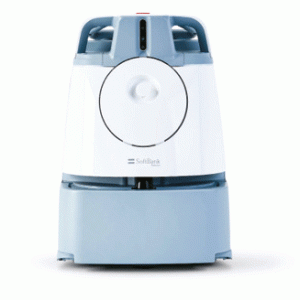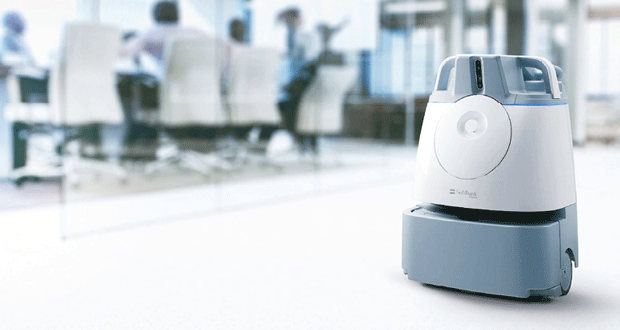Flooring maintenance and upkeep often requires a labour-intensive approach. Stefano Bensi, General Manager SoftBank Robotics EMEA explains how floors can be kept clean and in good condition through the use of collaborative robotics
An under-appreciated but crucial aspect of facilities management is the upkeep and maintenance of flooring. It’s a part of a building that can make or break the space. Although it’s not the first thing an employee or visitor sees, it’s the first physical contact someone will have with the building. The bad news is that where there is repeated high footfall across large surfaces areas, such as offices or hospitality venues, floors need to be maintained regularly and often by hand.
For facilities managers, this represents a time and labour-intensive task, not made easier by the current staffing challenges sweeping through service industries. As recently as May, the British Cleaning Council Chairman Jim Melvin accused the government of “once again ignoring the million-plus vacancies that cannot be filled”.
One consequence of these staffing shortages is underservicing, or not completing floor maintenance to a satisfactory standard, and this can lead to damage, negative health effects for occupiers and higher spending. For example, replacing just one square footage of flooring can cost anywhere upwards of £80 for a low-to-medium specification of carpet.
So, what can facilities management teams do about it? As is the case with most other industries, it’s becoming impossible to ignore the impact and potential of technology to transform cleaning services. Innovations in so-called “smart” technology, such as robotics, AI, and the internet of things, have the potential to increase efficiencies, provide a whole new level of accuracy and robustness to decision-making, and support staff to a greater extent.
Last year, in a SoftBank Robotics survey of facilities management professionals, 79 per cent agreed that real-time data from smart technology solutions was important for measuring cleaning services, despite nearly one in three (30 per cent) claiming they lacked the knowledge of what’s available in the market.
HEALTH AND HAPPINESS
Sound carpet cleanliness and upkeep brings with it an investment of longevity, durability and cleanliness, so extending the lifespan and timeliness of any replacement. Soil and dirt can damage carpet fibre and, if left for enough time, will eventually bring the useful life of the carpet to an untimely demise, resulting in extra labour, costing and materials.
That’s not all. Businesses also need to consider that a clean floor contributes directly to the health, comfort, and happiness of occupants. Carpets do a great job of acting as a filter, trapping damaging air pollutants such as pollen fungi, chemicals, bacteria, and other residues. When there’s insufficient vacuuming, however, these substances and pollutants can build up, which is bad news for people with asthma, other allergies, eczema and susceptible to rhinitis. This can also lead to poorer air quality, a particularly worrying outcome now that organisations are working hard to make their indoor environments safer considering what we know about the dangers of virus transmission since the onset of COVID-19.
Alongside creating a healthier environment, flooring can enhance the guest or employee experience. A well-maintained carpet enhances insulation and comfort, ensuring people have an optimal working environment. One Harvard study, published in 2021, found that poor air quality may even diminish people’s cognition and productivity.
ENVIRONMENTAL IMPACT
As businesses move ahead with more environmentally conscious practices, it’s important to remember that underservicing carpet over time will result in the need to refurbish, repair, or replace with greater frequency. Each of these acts has its own associated environmental impact to some degree, meaning flooring upkeep is an integral part of any sustainability strategy or commitments.
In 2021, the carpet industry was valued as a £199 million industry, with UK manufacturers selling an estimated £645 million worth of tufted textile floor coverings. It’s suggested that the driving force behind this upwardly growing industry is the continuous need for replacement and refurbishment of flooring, resulting in around 130,000 tonnes of carpet incinerated annually. With the consideration of just how much we interact with carpet on a day-to-day basis, there is significant foot traffic across offices and public spaces that they’re within. These statistics reflect the need for meaningful action to preserve carpeting with sound and thorough cleaning.
THE SMART AGE
That’s where technology comes in. AI-based technology shouldn’t be feared. Collaborative robots (cobots) are described as such because they exist to support the teams that deploy them and they do this by taking responsibility for the time-consuming and labour-intensive tasks, such as vacuuming large floor surface areas.
Generally, cobots undertake the monotonous, dirty, or hazardous stuff. Clearly, during a time when teams are understaffed, the technology will help fill those gaps by allowing cleaners to do more in a shorter space of time. What’s more, it frees them up to concentrate on higher value or more specialised tasks they know are important to the client and ensure a higher level of quality control across the operation. Importantly, cleaners still play a crucial role in the operation of these cobots by helping them learn the routes, recharging their batteries, emptying them when they are full and aiding them if they get stuck.
 As AI gets smarter, those in charge of cleaning operations must also consider the extent to which data can improve floor maintenance and upkeep. Cobots can be connected to a SaaS application that handles cleaning data. This integration captures each commercial robot vacuum’s coverage and runtime, plus identifies and reminds users of regular maintenance needs for peak performance. Through the data collection dashboard, users can provide employees and guests visibility into cleaning operation and confidence in the health and safety of their surroundings. The reporting features track business goals and provide actionable suggestions to get the most out of the cobot. The combination of telemetry with data analytics, machine learning, and a responsive user experience supports users in better managing their environments and quantifying robotics’ value to their workplaces.
As AI gets smarter, those in charge of cleaning operations must also consider the extent to which data can improve floor maintenance and upkeep. Cobots can be connected to a SaaS application that handles cleaning data. This integration captures each commercial robot vacuum’s coverage and runtime, plus identifies and reminds users of regular maintenance needs for peak performance. Through the data collection dashboard, users can provide employees and guests visibility into cleaning operation and confidence in the health and safety of their surroundings. The reporting features track business goals and provide actionable suggestions to get the most out of the cobot. The combination of telemetry with data analytics, machine learning, and a responsive user experience supports users in better managing their environments and quantifying robotics’ value to their workplaces.
Businesses are starting to embrace advancing technologies as a viable solution. Indeed, the market for collaborative robots reflects the growing successful integration into businesses, with the market share expected to expand annually an estimated 32 per cent, from 2023 to 2030. The bottom line is that keeping flooring in good condition is crucial but a growing challenge during this period of staffing shortages, with teams being stretched further and further, and technology presents an incredible opportunity to forge a path forward.





